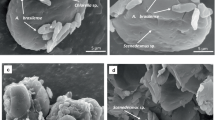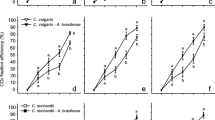Abstract
The mutualistic interactions of microalgae with other microorganisms can be altered by different culture conditions or environment factors. The mutualistic interaction of the bacterium Azospirillum brasilense co-cultured in suspension with the microalgae Chlorella sp. and Scenedesmus sp. under heterotrophy was evaluated in this study. The results demonstrated that the production of indole-3-acetic acid (IAA) and tryptophan (Trp) by the bacterium and microalgae, respectively, allowed maintain their affinity and mutualistic association under a heterotrophic regime. However, the glucose uptake of the consortium depends on the culture system, immobilized, or in suspension. Co-cultured in suspension with the bacterium, the biomass production of Chlorella sp. (0.8 ± 0.1 g L−1) and Scenedesmus sp. (0.9 ± 0.1 g L−1) and cell compound accumulation—mostly carbohydrates and proteins—were higher than when each microalga was cultured alone. Overall, these results demonstrated that, co-cultured in suspension, A. brasilense can be a suitable partner to Chlorella sp. and Scenedesmus sp., highlighting that the compatibility and mutualistic interaction of this consortium does not change under different culture systems and growth conditions. Also, this study expands the biotechnological potential of this consortium microalgal-Azospirillum as well as its incidence in different bioprocesses supported by microalgae.







Similar content being viewed by others
Data availability
All data generated or analyzed during this study are included in this published article and its supplementary information file.
References
Barbosa-Nuñez JA, Palacios OA, de-Bashan LE, Snell-Castro R, Corona-González RI, Choix FJ (2022a) Active indole-3-acetic acid biosynthesis by the bacterium Azospirillum brasilense cultured under a biogas atmosphere enables its beneficial association with microalgae. J Appl Microbiol 132:3650–3663
Barbosa-Nuñez JA, Palacios OA, Mondragón-Cortez P, Ocampo-Alvarez H, Becerril-Espinosa A, Nevárez-Moorillón GV, Choix FJ (2022b) Chemical and physical affinity of microalga–Azospirillum consortium co-cultured in suspension during CO2 fixation from biogas. Bioenergy Res. https://doi.org/10.1007/s12155-022-10411-7
Bhattacharya M, Goswami S (2020) Microalgae – A green multi-product biorefinery for future industrial prospects. Biocatal Agric Biotechnol 25:101580
Bligh EG, Dyer WJ (1959) A rapid method of total lipid extraction and purification. Can J Biochem 37:911–917
Carone M, Corato A, Dauvrin T, Le Thanh T, Durante L, Joris B, Franck F, Remacle C (2019) Heterotrophic growth of microalgae. In: Hallmann A, Rampelotto PH (eds) Grand Challenges in Algae Biotechnology. Springer, Cham, pp 71–109
Choix FJ, de-Bashan LE, Bashan Y (2012) Enhanced accumulation of starch and total carbohydrates in alginate-immobilized Chlorella spp. induced by Azospirillum brasilense: I. Autotrophic conditions. Enzyme Microb Technol 51:294–299
Choix FJ, Polster E, Corona-González RI, Snell-Castro R, Méndez-Acosta HO (2017) Nutrient composition of culture media induces different patterns of CO2 fixation from biogas and biomass production by the microalga Scenedesmus obliquus U169. Bioprocess Biosyst Eng 40:1733–1742
Choix FJ, López-Cisneros CG, Méndez-Acosta HO (2018) Azospirillum brasilense increases CO2 fixation on microalgae Scenedesmus obliquus, Chlorella vulgaris, and Chlamydomonas reinhardtii cultured on high CO2 concentrations. Microb Ecol 76:430–442
Covarrubias SA, de-Bashan LE, Moreno M, Bashan Y (2012) Alginate beads provide a beneficial physical barrier against native microorganisms in wastewater treated with immobilized bacteria and microalgae. Appl Microbiol Biotechnol 93:2669–2680
de-Bashan LE, Hernandez JP, Morey T, Bashan Y (2004) Microalgae growth promoting bacteria as “helpers” for microalgae: A novel approach for removing ammonium and phosphorus from municipal wastewater. Water Res 38:466–474
de-Bashan LE, Antoun H, Bashan Y (2008) Involvement of indole-3-acetic acid produced by the growth-promoting bacterium Azospirillum spp. in promoting growth of Chlorella vulgaris. J Phycol 44:938–947
de-Bashan LE, Schmid M, Rothballer M, Hartmann A, Bashan Y (2011) Cell-cell interaction in the eukaryote-prokaryote model of the microalgae Chlorella vulgaris and the bacterium Azospirillum brasilense immobilized in polymer beads. J Phycol 47:1350–1359
de-Bashan LE, Mayali X, Bebout BM, Weber PK, Detweiler AM, Hernandez JP, Bashan Y (2016) Establishment of stable synthetic mutualism without co-evolution between microalgae and bacteria demonstrated by mutual transfer of metabolites (NanoSIMS isotopic imaging) and persistent physical association (Fluorescent in situ hybridization). Algal Res 15:179–186
Dubois M, Gilles KA, Hamilton JK, Rebers PT, Smith F (1956) Colorimetric method for determination of sugars and related substances. Anal Chem 28:350–356
Ganusova EE, Vo LT, Mukherjee T, Alexandre G (2021) Multiple CheY proteins control surface-associated lifestyles of Azospirillum brasilense. Front Microbiol 12:900
Goebel EM, Krieg NR (1984) Fructose catabolism in Azospirillum brasilense and Azospirillum lipoferum. J Bacteriol 159:86–92
González-González LM, de-Bashan LE (2021) Toward the enhancement of microalgal metabolite production through microalgae–bacteria consortia. Biology 10:282
Guldhe A, Ansari FA, Singh P, Bux F (2017) Heterotrophic cultivation of microalgae using aquaculture wastewater: a biorefinery concept for biomass production and nutrient remediation. Ecol Eng 99:47–53
Guo Z, Tong YW (2013) The interactions between Chlorella vulgaris and algal symbiotic bacteria under photoautotrophic and photoheterotrophic conditions. J Appl Phycol 26:1483–1492
Kargapolova KY, Burygin GL, Tkachenko OV, Evseeva NV, Pukhalskiy YV, Belimov AA (2020) Effectiveness of inoculation of in vitro-grown potato microplants with rhizosphere bacteria of the genus Azospirillum. Plant Cell Tissue Organ Cult 141:351–359
Li Y, Han D, Sommerfeld M, Hu Q (2011) Photosynthetic carbon partitioning and lipid production in the oleaginous microalga Pseudochlorococcum sp. (Chlorophyceae) under nitrogen-limited conditions. Bioresour Technol 102:123–129
Li T, Yang F, Xu J, Wu H, Mo J, Dai L, Xiang W (2020) Evaluating differences in growth, photosynthetic efficiency, and transcriptome of Asterarcys sp. SCS-1881 under autotrophic, mixotrophic, and heterotrophic culturing conditions. Algal Res 45:101753
Lowry OH, Rosebrough NJ, Farr AL, Randall RJ (1951) Protein measurement with the folin phenol reagent. J Biol Chem 193:265–275
Masciarelli O, Urbani L, Reinoso H, Luna V (2013) Alternative mechanism for the evaluation of indole-3-acetic acid (IAA) production by Azospirillum brasilense strains and its effects on the germination and growth of maize seedlings. J Microbiol 51:590–597
Morales-Sánchez D, Martinez-Rodriguez OA, Kyndt J, Martinez A (2015) Heterotrophic growth of microalgae: metabolic aspects. World J Microbiol Biotechnol 31:1–9
Nirmalakhandan N, Selvaratnam T, Henkanatte-Gedera SM, Tchinda D, Abeysiriwardana-Arachchige ISA, Delanka-Pedige HMK, Lammers PJ (2019) Algal wastewater treatment: Photoautotrophic vs. mixotrophic processes. Algal Res 41:101569
Okon Y, Itzigsohn R (1992) Poly-β-hydroxybutyrate metabolism in Azospirillum brasilense and the ecological role of PHB in the rhizosphere. FEMS Microbiol Rev 9:131–139
Pagnussat LA, Maroniche G, Curatti L, Creus C (2020) Auxin-dependent alleviation of oxidative stress and growth promotion of Scenedesmus obliquus C1S by Azospirillum brasilense. Algal Res 47:101839
Palacios OA, Choix FJ, Bashan Y, de-Bashan LE (2016) Influence of tryptophan and indole-3-acetic acid on starch accumulation in the synthetic mutualistic Chlorella sorokiniana-Azospirillum brasilense system under heterotrophic conditions. Res Microbiol 167:367–379
Palacios OA, Gomez-Anduro G, Bashan Y, de-Bashan LE, (2016) Tryptophan, thiamine and indole-3-acetic acid exchange between Chlorella sorokiniana and the plant growth-promoting bacterium Azospirillum brasilense. FEMS Microbiol Ecol 92:fiw077
Palacios OA, López BR, de-Bashan LE (2022) Microalga Growth-Promoting Bacteria (MGPB): A formal term proposed for beneficial bacteria involved in microalgal–bacterial interactions. Algal Res 61:102585
Patel AK, Choi YY, Sim SJ (2020) Emerging prospects of mixotrophic microalgae : Way forward to sustainable bioprocess for environmental remediation and cost-effective biofuels. Bioresour Technol 300:122741
Peng H, de-Bashan LE, Bashan Y, Higgins BT (2020) Indole-3-acetic acid from Azosprillum brasilense promotes growth in green algae at the expense of energy storage products. Algal Res 47:101845
Peng H, de-Bashan LE, Higgins BT (2021) Comparison of algae growth and symbiotic mechanisms in the presence of plant growth promoting bacteria and non-plant growth promoting bacteria. Algal Res 53:102156
Peng H, de-Bashan LE, Higgins BT (2021) Azospirillum brasilense reduces oxidative stress in the green microalgae Chlorella sorokiniana under different stressors. J Biotechnol 325:179–185
Perez-Garcia O, Escalante FME, de-Bashan LE, Bashan Y (2011) Heterotrophic cultures of microalgae: Metabolism and potential products. Water Res 45:11–36
Pham TM, Bui XD, Le TVK, Le TM, Nguyen ML, Trinh DM, Phuong NTD, Khoo KS, Chew KW, Show PL (2022) Isolation of indole-3-acetic acid-producing Azospirillum brasilense from Vietnamese wet rice: co-immobilization of isolate and microalgae as a sustainable biorefinery. J Biotechnol 349:12–20
Pistorius AMA, DeGrip WJ, Egorova-Zachernyuk TA (2009) Monitoring of biomass composition from microbiological sources by means of FT-IR spectroscopy. Biotechnol Bioeng 103:123–129
Puente ML, Maroniche GA, Panepucci M, Sabio y Garcia J, García JE, Criado MV, Molina R, Cassán F (2021) Localization and survival of Azospirillum brasilense Az39 in soybean leaves. Lett Appl Microbiol 72:626–633
Ramanan R, Kim BH, Cho DH, Oh HM, Kim HS (2016) Algae-bacteria interactions: Evolution, ecology and emerging applications. Biotechnol Adv 34:14–29
Ramos-Ibarra JR, Rubio-Ramírez TE, Mondragón-Cortez P, Torres-Velázquez JR, Choix FJ (2019) Azospirillum brasilense-microalga interaction increases growth and accumulation of cell compounds in Chlorella vulgaris and Tetradesmus obliquus cultured under nitrogen stress. J Appl Phycol 31:3465–3477
Ren X, Murray RM (2019) Cooperation enhances robustness of coexistence in spatially structured consortia. In: 2019 18th European Control Conference, ECC, pp 2651–2656
Rosero-Chasoy G, Rodríguez-Jasso RM, Aguilar CN, Buitrón G, Chairez I, Ruiz HA (2021) Microbial co-culturing strategies for the production high value compounds, a reliable framework towards sustainable biorefinery implementation – an overview. Bioresour Technol 321:124458
Ruiz-Güereca DA, Sánchez-Saavedra MP (2016) Growth and phosphorus removal by Synechococcus elongatus co-immobilized in alginate beads with Azospirillum brasilense. J Appl Phycol 28:1501–1507
Shibl AA, Isaac A, Ochsenkuhn MA, Cárdenas A, Fei C, Behringer G, Arnoux M, Drou N, Santos MP, Gunsalus KC, Voolstra CR, Amin SA (2020) Diatom modulation of select bacteria through use of two unique secondary metabolites. Proc Nat Acad Sci 117:27445–27455
Smith DL, Johnson KB, Darmstadt TU (1996) A guide to marine coastal plankton and marine invertebrate larvae. Kendall/ Hunt Publishing Company, Iowa
Stirk WA, Van Staden J (2020) Potential of phytohormones as a strategy to improve microalgae productivity for biotechnological applications. Biotechnol Adv 44:107612
Stuart BH (2004) Infrared spectroscopy: fundamentals and applications. Wiley, Canada
Variem SS, Kizhakkedath VK (2021) Phycosphere associated bacteria; a prospective source of bioactive compounds. Biologia 76:1095–1098
Wheatley RM, Poole PS (2018) Mechanisms of bacterial attachment to roots. FEMS Microbiol Rev 42:448–461
Yong JJJY, Chew KW, Khoo KS, Show PL, Chang JS (2021) Prospects and development of algal-bacterial biotechnology in environmental management and protection. Biotechnol Adv 47:107684
Zhang B, Li W, Guo Y, Zhang Z, Shi W, Cui F, Tay JH (2020) Microalgal-bacterial consortia: From interspecies interactions to biotechnological applications. Renew Sustain Energy Rev 118:109563
Zhuang LL, Li M, Hao Ngo H (2020) Non-suspended microalgae cultivation for wastewater refinery and biomass production. Bioresour Technol 308:123320
Acknowledgements
Francisco J. Choix acknowledges Consejo Nacional de Ciencia y Tecnología (CONACyT,
Mexico) for the support under the Program-Project 90 Cátedras CONACyT and Martín Flores Martínez and Sergio Oliva León for scanning electron microscopy (SEM) service of CUCEI-UdG. JCEH are thankful to the Consejo Nacional de Ciencia y Tecnologìa (CONACYT,Mexico) for a grant to purchase the NMR instrument (INFR-2014-01-226114).
Funding
This study was funded by CONACyT- Frontiers of Science 2019 Project 15769.
Author information
Authors and Affiliations
Contributions
FJC and OAP designed the research; JRTV, CACG and JCEH supervised the research; JRTV and CACG performed the research and statistical analysis; FJC, OAP, MCP and JCEH analyzed and interpreted the data; FJC, OAP, MCP and JCEH wrote the paper. All the authors read and approved the final manuscript.
Corresponding author
Ethics declarations
Conflict of interest
The authors declare that they have no conflict of interest.
Additional information
Publisher's note
Springer Nature remains neutral with regard to jurisdictional claims in published maps and institutional affiliations.
Supplementary Information
Below is the link to the electronic supplementary material.
10811_2022_2891_MOESM1_ESM.pdf
Supplementary file1 Qualitative biomass characterization and glucose uptake of A. brasilense cultured in suspension or immobilized in alginate beads under heterotrophic growth. (PDF 114 KB)
Rights and permissions
Springer Nature or its licensor (e.g. a society or other partner) holds exclusive rights to this article under a publishing agreement with the author(s) or other rightsholder(s); author self-archiving of the accepted manuscript version of this article is solely governed by the terms of such publishing agreement and applicable law.
About this article
Cite this article
Choix, F.J., Palacios, O.A., Contreras, C.A. et al. Growth and metabolism enhancement in microalgae co-cultured in suspension with the bacterium Azospirillum brasilense under heterotrophic conditions. J Appl Phycol 35, 57–71 (2023). https://doi.org/10.1007/s10811-022-02891-z
Received:
Revised:
Accepted:
Published:
Issue Date:
DOI: https://doi.org/10.1007/s10811-022-02891-z




